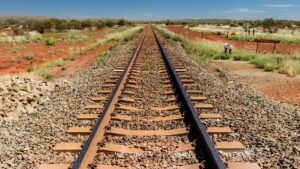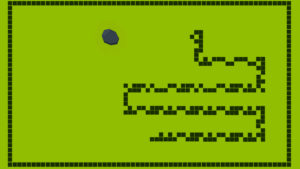Bulk Buys: Back from the wilderness, can this forgotten stock make junior iron ore happen?

Pic: Dina Belenko Photography/E+ via Getty Images
- After dumping a controversial mega iron ore project, can the former Flinders Mines reinvent itself as the king of the iron ore juniors?
- MD Steven Michael says the new development plan for rebadged Red Hawk Mining would see a small scale project of around 3Mtpa built for just $150 million
- It’s a change of course after dumping the 50Mtpa Balla Balla proposal, the source of serious conflict between major Kiwi shareholder Todd Corporation and 4000 retail holders
Iron ore is a big dog’s game and juniors have been battling for time in the box seat since Gretchen Wieners tried to make fetch happen.
Those who have succeeded have tended to be small producers of niche high grade products. Think magnetite supremos Grange Resources (ASX:GRR) and Champion Iron (ASX:CIA), or near 65% Fe hematite shippers Mt Gibson Iron (ASX:MGX) and Fenix Resources (ASX:FEX), all of whom make up for their high cost base with big premiums for their high grade material.
Smaller fish like BC Iron (now salt hopeful BCI Minerals) and Atlas Iron have come and gone, the latter now part of the Hancock/Roy Hill portfolio.
And aside from Andrew Forrest’s Fortescue (ASX:FMG), the well-heeled Roy Hill — 70% owned by Perth billionaire Gina Rinehart and backed by steelmaking customers including South Korea’s POSCO — and to some extent Mineral Resources (ASX:MIN) none have made a real dent in the cozy oligopoly enjoyed by the world’s three biggest producers, Rio Tinto (ASX:RIO), Vale and BHP (ASX:BHP).
One that tried was Flinders Mines, a company founded to hunt diamonds in South Australia that later became the cornerstone of a ploy by Kiwi capitalists the Todd Corporation to muscle in on the Aussie iron ore game.
Their Balla Balla Infrastructure Group inked a State Agreement in 2017 to export around 50Mt of iron ore each year through a new Pilbara port to the north of Rio’s Dampier and Cape Lambert harbours.
The problem? Not only is the iron ore price volatile — in May 2021 it rose to a record US$237/t on all time Chinese steel output before falling back to US$87/t in November of that year — but the roughly 1.5 billion tonnes of ore the JV counted as its Pilbara Iron Ore Project resource boasted a grade of just 52% Fe, so low not even Twiggy would dare stare it in the face.
Now Flinders Mines has rebadged as Red Hawk Mining (ASX:RHK), ditched Balla Balla, and set a new course with the intention of being the player that makes junior iron ore work.
The jam and the cream
Instead Red Hawk will be focused on a single mining lease called the Blacksmith project, where a recent scoping study outlined plans to produce a far more modest 3Mtpa over two decades of mine life.
That is focused on two deposits — Delta and Paragon — which collectively grade 100.1Mt at 60.1% Fe, all above the water table, a key concern for traditional owner stakeholders.
In doing so, Red Hawk will be able to produce a product far closer to the 62% Fe benchmark iron ore index — US$122.75/t yesterday — a substitute material of sorts for Rio’s market leading Pilbara Blend fines and lump products.
New Red Hawk MD Steven Michael describes it as taking just the jam and the cream on top of the scone, contained in the canga and Dales Gorge Member units close to surface.
And short of the multi-billion buck capex required to deliver a large scale iron ore project, the company anticipates it could cost just $150m to bring the mine into operation with an IRR of 35% and payback inside 3.1 years at long term S&P iron ore price forecasts of US$89/t and cash costs of US$50/t.
There is some evidence the market was on board. $110 million capped Red Hawk rerated from 40c in mid-June to 79c by mid-September, falling since to around 62c.
The initial two years will see higher grades of 62% Fe product sent to sea, something that could be extended if Red Hawk can bring additional high grade resources in from its Blackjack and Champion deposits.
Based off 200km of drilling across seven deposits between 2008 and 2017, RHK is sitting on 173.8Mt at a grade of 60% Fe, 95% of that indicated, meaning it can be put into a reserve calculation at the right price.
That resource base, Michael says, is as large as the whole small end of the WA iron ore sector once the top five producers and magnetite operators are taken out of the equation.
“Compared to the ASX listed junior iron ore space, excluding magnetite resources because magnetite’s a very different type of mineralisation, processing and market,” he said.
“But you can see that we are essentially an order of magnitude bigger than the other juniors. If you add up all of the other juniors, they’re about 200Mt at 58% … and we’re 175 at 60.
“So we’re essentially the same size as all the other junior iron ore companies put together.”
Out to port
Red Hawk has already raised $6.3 million to progress a pre-feasibility study, and Michael has flagged the potential to increase its scale as the project, heads to development. A FID is due in H2 2024 and production anticipated in 2025.
“We can be that long term large scale junior iron ore company, where a lot of our peer group can deliver 1-2 million tonnes for three to five years,” he said.
“If we can go beyond three and go up to 5 or 7 million tonnes, this will be the biggest junior iron ore producer that we’ve had in WA. I think in its heyday, Atlas was probably doing 5 or 7 million tonnes a year. Gina with Atlas nowadays is about 8 million tons (8.9Mt in 2022-23), but that’s from a number of mines.
“So this will be a really big junior iron ore play which hopefully – and the cost structure we’ve gotten in place throughout the scoping study, US$50 onto a ship – should mean that we’re a lot more insulated from the volatility of the price cycle.
“And that’s where iron ore juniors, like any commodity, you make money for a few years and then the price drops down and you’re done.”
The mine plan is in part constrained by capacity at Utah Point, a dedicated facility at Port Hedland for small iron ore producers currently accessed by MinRes and Atlas.
That comes with myriad challenges. At $45 Aussie per wet metric tonne, the trucking leg is by far the costliest part of the operation.
Rio, BHP and FMG are able to maintain costs of US$20/t give or take a dollar-y-doo or two because they own their own port and rail infrastructure. In Rio’s case it is the only iron ore company using the berths at Dampier and Cape Lambert.
Utah Point is ready to go if Blacksmith were in operation today. But it’s around 450km to port. Far closer are ports being built for salt exporters and a JV between CSL and fellow small scale iron ore hopefuls CZR Resources (ASX:CZR) and Strike Resources (ASX:SRK) to create a new export facility at the Port of Ashburton.
“If there was another option that opened up that was shorter, and gave us at least the same amount of capacity, we would probably look at that,” Michael said.
“But it’s all about timing versus available capacity because one thing that this project suffered from in the past is almost trying to wait to build the perfect project.
“And if you try to build the perfect project, you can be here for 10 years, as we have been, and maybe another 10 years.
“So I’d rather get up and running and if it means that we do 3 million tonnes out of Utah Point for the first five years while we’re waiting for another port to open up, we’ll do that.”
Don’t make me a target
Michael and Red Hawk chair Cheryl Edwardes have arguably had tougher jobs in mining, including stints as key decision makers at WA uranium play Vimy Resources in the midst of decade-low uranium prices.
They eventually merged the Mulga Rock uranium project owner with Namibian focused Deep Yellow (ASX:DYL), now worth $915 million.
At Red Hawk they’re playing in a much bigger yard, the Blacksmith tenement bounded on either side by Rio Tinto to the north and FMG to the east.
Michael thinks Blacksmith now has more appeal to other iron ore producers than the cumbersomely large, 52% Pilbara Iron Ore Project.
For perspective, Rio’s major growth project in the Pilbara, Rhodes Ridge, contains 6.7Bt at 61.6% Fe.
If Rio or another iron ore major wanted to consume Blacksmith, it would be easier and cheaper to just buy Todd’s still controlling 59% stake in the junior. Another big investor, Melbourne-based but Chinese linked OCJ Investments, boasts around 21%.
That means there’s precious little liquidity for institutional shareholders to take a punt on.
But the company has also been mired in controversies stemming from the breakdown in relations between Todd and around 4000 minority retail holders, who fought among other things plans for Todd to delist the old Flinders around five years ago.
A large part of Michael’s job will be getting retails onside and bring instos on board, starting with roadshows last month, though whether Todd and OCJ will be diluted is another question.
Todd has two representatives on RHK’s seven strong board. Michael thinks Todd is treading carefully in ensuring it is not seen to act in a manner prejudicial to other shareholders, pointing to the hefty 25% discount and 1-for-12 offer price in a recent 45c per share entitlement issue as an olive branch to long-suffering holders.
If RHK can get it right, the prize could be developing a new project in an iron ore market that may be materially stronger than many analysts believe.
“When you look at China as the biggest consumer of iron ore in the world, if you look at what’s happened recently, the Chinese economy has slowed considerably,” Michael said.
“Yet, demand for iron ore and (the) price of iron ore hasn’t come off … probably different to what people expected. And I think when you look at iron ore into the next, say the next 10 years, assuming even a small increase in growth globally, the only big increases in iron ore to come out in the world will be West Africa.
“Guinea, Simandou, those kinds of operations.
“And potentially they’ll add 100-150 million tonnes in a global market which is roughly 2 billion tonnes.
“It’s barely making the replacement for mines that are going out of production.”
ASX iron ore stocks
Scroll or swipe to reveal table. Click headings to sort.
| CODE | COMPANY | PRICE | WEEK RETURN % | MONTH RETURN % | 6 MONTH RETURN % | YEAR RETURN % | MARKET CAP |
|---|---|---|---|---|---|---|---|
| ACS | Accent Resources NL | 0.008 | 0% | 0% | -20% | -68% | $ 3,785,018.26 |
| ADY | Admiralty Resources. | 0.005 | 0% | 0% | -17% | -29% | $ 6,517,895.77 |
| AKO | Akora Resources | 0.145 | -3% | 0% | -3% | -22% | $ 13,772,508.03 |
| BCK | Brockman Mining Ltd | 0.028 | -3% | -7% | -7% | 22% | $ 269,126,731.80 |
| BHP | BHP Group Limited | 45.56 | 2% | 4% | 3% | 13% | $ 230,323,535,921.28 |
| CIA | Champion Iron Ltd | 7.85 | 10% | 32% | 24% | 56% | $ 3,946,966,458.05 |
| CZR | CZR Resources Ltd | 0.19 | 6% | 41% | 15% | -20% | $ 43,610,909.51 |
| DRE | Dreadnought Resources Ltd | 0.033 | 3% | -25% | -45% | -67% | $ 114,079,194.90 |
| EFE | Eastern Resources | 0.008 | 0% | -11% | -27% | -78% | $ 9,935,571.69 |
| CUF | Cufe Ltd | 0.011 | -8% | -8% | -15% | -19% | $ 12,607,236.02 |
| FEX | Fenix Resources Ltd | 0.235 | 2% | 4% | 0% | 12% | $ 166,598,860.80 |
| FMG | Fortescue Metals Grp | 23.36 | 5% | 11% | 15% | 40% | $ 71,493,565,395.96 |
| RHK | Red Hawk Mining Ltd | 0.62 | -2% | -10% | 32% | 34% | $ 104,686,117.74 |
| GEN | Genmin | 0.18 | 0% | 0% | 13% | -36% | $ 81,275,982.12 |
| GRR | Grange Resources. | 0.465 | 12% | 2% | -22% | -35% | $ 538,162,494.57 |
| GWR | GWR Group Ltd | 0.08 | -1% | 3% | 4% | 40% | $ 24,733,682.44 |
| HAV | Havilah Resources | 0.24 | 12% | -4% | -8% | -23% | $ 75,993,410.40 |
| HAW | Hawthorn Resources | 0.1 | 5% | -5% | 33% | 8% | $ 33,501,561.30 |
| HIO | Hawsons Iron Ltd | 0.052 | 2% | 0% | 2% | -50% | $ 47,791,695.07 |
| IRD | Iron Road Ltd | 0.079 | 11% | -5% | -17% | -44% | $ 64,795,876.79 |
| JNO | Juno | 0.08 | 3% | 3% | -4% | -15% | $ 10,852,640.08 |
| LCY | Legacy Iron Ore | 0.017 | 0% | -11% | 6% | 0% | $ 108,916,045.38 |
| MAG | Magmatic Resrce Ltd | 0.059 | 2% | -2% | -55% | -53% | $ 17,730,182.28 |
| MDX | Mindax Limited | 0.053 | 15% | 6% | -66% | -10% | $ 102,277,939.00 |
| MGT | Magnetite Mines | 0.295 | -20% | -2% | -47% | -64% | $ 23,413,339.95 |
| MGU | Magnum Mining & Exp | 0.028 | 22% | 17% | 47% | -10% | $ 21,704,257.88 |
| MGX | Mount Gibson Iron | 0.54 | 9% | 21% | 21% | 29% | $ 643,642,246.49 |
| MIN | Mineral Resources. | 60.06 | 4% | -1% | -15% | -20% | $ 11,840,008,722.48 |
| MIO | Macarthur Minerals | 0.16 | 0% | -6% | 7% | 10% | $ 26,568,558.08 |
| PFE | Panteraminerals | 0.058 | -11% | 0% | -32% | -61% | $ 6,424,352.94 |
| PLG | Pearlgullironlimited | 0.025 | 0% | -4% | -24% | 19% | $ 5,113,544.75 |
| RHI | Red Hill Minerals | 4.5 | -6% | 2% | 0% | 27% | $ 287,226,670.50 |
| RIO | Rio Tinto Limited | 121.81 | 4% | 8% | 11% | 27% | $ 45,102,770,001.00 |
| RLC | Reedy Lagoon Corp. | 0.004 | 0% | -43% | -31% | -59% | $ 3,083,417.95 |
| CTN | Catalina Resources | 0.004 | 0% | 0% | -20% | -43% | $ 4,334,704.12 |
| SRK | Strike Resources | 0.054 | -7% | -4% | -8% | -46% | $ 15,322,500.00 |
| SRN | Surefire Rescs NL | 0.011 | -31% | -21% | -35% | -8% | $ 19,859,218.87 |
| TI1 | Tombador Iron | 0.014 | 0% | 0% | -33% | -36% | $ 30,218,753.22 |
| TLM | Talisman Mining | 0.145 | -6% | 12% | -6% | 9% | $ 28,248,052.35 |
| VMS | Venture Minerals | 0.01 | 11% | -9% | -44% | -50% | $ 17,550,117.32 |
| EQN | Equinoxresources | 0.17 | 0% | -13% | 31% | 42% | $ 15,280,000.48 |
| AMD | Arrow Minerals | 0.002 | 100% | -20% | -50% | -56% | $ 6,047,530.19 |
Mind the gap
Front month Newcastle thermal coal futures meanwhile continue to look relatively weak, trading at US$122.50/t.
It comes as energy coal miners, led by Whitehaven (ASX:WHC), look to pivot towards metallurgical coal in the belief the steelmaking commodity has a longer runway before technology exists to displace it.
The same month’s Singapore futures for coking coal are paying US$316/t, a sign of the massive premium being paid for top quality hard coking coal.
At the same time, it hasn’t been a magic wand in 2023. Case in point, the travails of Bowen Coking Coal (ASX:BCB), which has seen its operations struggle with supply chain blockages and lower prices for the PCI coal it was selling from its Bluff mine due to discounting from Russian suppliers.
Its new plan will focus on generating the bulk of its production from Ellensfield South — a pit that delivers higher yielding met coal at a lower strip ratio than the Broadmeadow East pit, while Bluff has been mothballed.
Bowen emerged late last week from a $50m equity raising, its second similar share issue this year. That included a $17 million placement to instos which included $16m to a company owned by Hans Mende, exec chairman and half-owner of major coal investor AMCI Group.
It will likely see a representive of Mende’s join the board with support of Bowen’s existing directors.
ASX coal stocks
Scroll or swipe to reveal table. Click headings to sort.
| CODE | COMPANY | PRICE | WEEK RETURN % | MONTH RETURN % | 6 MONTH RETURN % | YEAR RETURN % | MARKET CAP |
|---|---|---|---|---|---|---|---|
| NAE | New Age Exploration | 0.006 | 20% | 0% | 20% | -20% | $ 10,763,393.46 |
| CKA | Cokal Ltd | 0.1 | -13% | -17% | -33% | -52% | $ 118,684,387.80 |
| BCB | Bowen Coal Limited | 0.091 | -19% | -22% | -58% | -68% | $ 219,111,649.91 |
| SVG | Savannah Goldfields | 0.051 | -2% | -14% | -67% | -77% | $ 10,222,451.58 |
| GRX | Greenx Metals Ltd | 0.91 | -3% | 1% | 25% | 184% | $ 259,529,765.65 |
| AKM | Aspire Mining Ltd | 0.078 | 11% | 0% | 34% | -7% | $ 39,595,684.83 |
| AVM | Advance Metals Ltd | 0.003 | 0% | -40% | -57% | -67% | $ 1,765,676.18 |
| YAL | Yancoal Aust Ltd | 4.57 | -5% | -7% | -13% | -14% | $ 6,113,634,593.31 |
| NHC | New Hope Corporation | 5.24 | -9% | -14% | 4% | -19% | $ 4,505,638,023.12 |
| TIG | Tigers Realm Coal | 0.005 | 0% | -17% | -17% | -67% | $ 65,333,511.84 |
| SMR | Stanmore Resources | 3.73 | -2% | 6% | 29% | 21% | $ 3,416,274,292.86 |
| WHC | Whitehaven Coal | 6.8 | -8% | 5% | 0% | -32% | $ 5,864,571,495.84 |
| BRL | Bathurst Res Ltd. | 0.98 | 1% | -3% | -3% | 9% | $ 186,575,785.50 |
| CRN | Coronado Global Res | 1.715 | -1% | 2% | 9% | -9% | $ 2,866,735,878.30 |
| JAL | Jameson Resources | 0.041 | 0% | -20% | -41% | -59% | $ 16,051,955.10 |
| TER | Terracom Ltd | 0.325 | -12% | -19% | -45% | -65% | $ 268,323,688.73 |
| ATU | Atrum Coal Ltd | 0.005 | 0% | 0% | 0% | -23% | $ 6,958,495.86 |
| MCM | Mc Mining Ltd | 0.17 | 31% | 26% | -19% | -35% | $ 79,311,668.28 |
| DBI | Dalrymple Bay | 2.73 | 1% | -1% | 4% | 10% | $ 1,368,302,200.92 |
| AQC | Auspaccoal Ltd | 0.125 | -11% | 0% | -27% | -46% | $ 63,843,240.16 |
UNLOCK INSIGHTS
Discover the untold stories of emerging ASX stocks.
Daily news and expert analysis, it's free to subscribe.
By proceeding, you confirm you understand that we handle personal information in accordance with our Privacy Policy.








